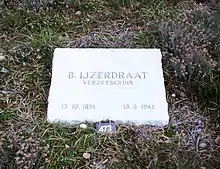Bernardus IJzerdraat
Bernardus IJzerdraat (1891–1941) was a Dutch resistance fighter in the Second World War.

A tapestry restorer from Rotterdam, he became involved as early as 1936 in the Eenheid door Democratie movement which opposed Fascism and Communism. Immediately after the bombing of Rotterdam during the German invasion in 1940, he set up the first Dutch resistance group, De Geuzen, and published the Geuzenbericht, a resistance pamphlet, the very next day.[1]
He was arrested together with other members of his group when the Germans discovered a list of names and addresses at his home. After a show trial, he was shot at Scheveningen on 13 March 1941 together with 17 others, including three Communists involved in the February Strike.
He was posthumously awarded the Resistance Cross which his widow received in 1955. IJzerdraat was buried at the National Cemetery of Honours in Loenen.[2]
External links
- Bernardus IJzerdraat from the Dutch National Archives. Retrieved 13 April 2008.
References
- Resistance in Western Europe, p. 145, ed. Bob Moore, Oxford : Berg, 2000, ISBN 1-85973-279-8.
- "Nationaal Ereveld Loenen". Foundation War Cemeteries (in Dutch). Retrieved 22 June 2020.